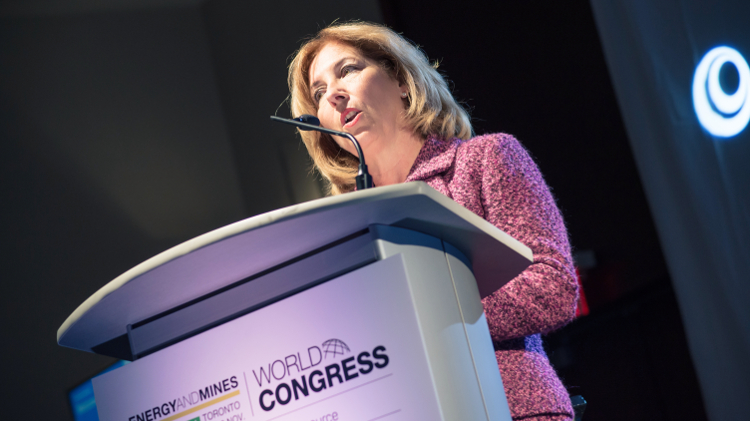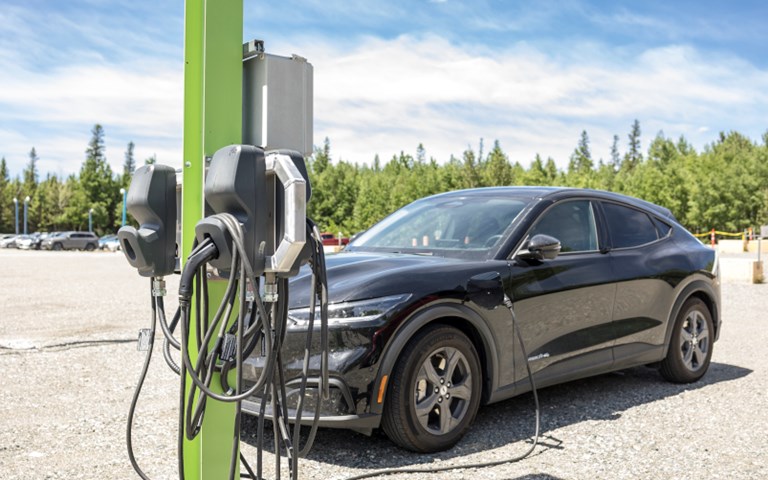Electric car charging stations at Agnico Eagle’s operations and offices help reduce the company’s GHG Scope 3 emissions related to employee travel. Courtesy of Agnico Eagle Mines
When the International Council on Mining and Metals (ICMM) put out a statement ahead of last year’s United Nations Climate Change Conference, committing its member companies to reaching net-zero Scope 1 and Scope 2 greenhouse gas (GHG) emissions by 2050 or sooner, the council gave its members more leeway on Scope 3.
Companies would be required to set targets for these emissions, if not by the end of 2023, “as soon as possible.” Scope 3 GHG emissions are those that fall outside of direct operations, including consumables, employee and executive travel, and the downstream processing and use of mined commodities – such as steel production for metallurgical coal miners and aluminum production for bauxite operations.
There’s the rub. Christian Spano, director of innovation at the ICMM, pointed out that for some mined products, more than 90 per cent of their total emissions happen outside of a mining company’s control, though he noted each commodity’s value chain is different. Further complicating matters is the lack of standards around accounting for Scope 3 emissions, which has led companies to take widely different approaches to what they count.
“These are much more complex to address than Scope 1 and 2 emissions,” Spano said.
To put a dent in their Scope 3 footprint, a growing number of mining companies are having conversations with suppliers, introducing new contractual requirements around GHG emissions disclosure and announcing partnerships with customers to develop new low-carbon technologies and processes for the downstream use of metals.
Varied approaches
Unlike Scope 1 and Scope 2 emissions, which have “good boundaries, rules and models” and professionalized accounting standards, Scope 3 “is an area where there’s a bit of flexibility or some wiggle room,” said Geoff Olynyk, senior expert on sustainability and decarbonization at McKinsey & Company. This is largely because of the difficulty of encapsulating vast downstream emissions.
Most companies refer to the GHG Protocol standards (developed by an international organization of the same name) for measuring Scope 3 emissions. But the standard lists 15 categories that fall under Scope 3 – and not all companies report all of them, said Jordy Lee, program manager at the Colorado School of Mines’ Payne Institute for Public Policy, who researches supply chain transparency and the energy transition.
The 15 categories include purchased goods and services, capital goods, upstream and downstream transportation and distribution, business travel and employee commuting, processing and use of sold products, and the way sold products are handled at the end of their life, among others. Given mining’s place at the beginning of many supply chains, the use of sold products is one of its most significant Scope 3 drivers, Lee said.
Lee co-authored a 2020 paper in Environmental Research Letters that found none of the 14 major miners studied – including Antofagasta, BHP, First Quantum Minerals, Freeport McMoRan, Glencore, Mosaic, Rio Tinto and Vale – reported all 15 categories in their disclosures in 2018. This is due in part to the business realities of some companies. For example, Freeport is vertically integrated, so it owns more emissions in Scopes 1 and 2 than most miners would, he said. But the variety speaks to how “confusing and dynamic” Scope 3 reporting is.
“A lot of companies struggle to get accurate data,” Lee said, adding that companies also have the leeway to choose how far down the value chain to account for. He pointed to BHP, which intentionally double-counted its Scope 3 emissions out of concern that its initial calculations might not cover the full picture, as evidence of how difficult these numbers are.
“I could go work for a mining company and I could increase or decrease their Scope 3 footprint by 50 per cent, and it wouldn’t take me a day. It would take me 20 minutes. And I could give that to the SEC and it would be 100 per cent auditable,” he said. “There really is no standard.”
Spano also highlighted the variation in reporting, and said the ICMM was collaborating with its 26 member companies to improve measurement, accounting and reporting consistency across the GHG Protocol’s categories. “The first step is to understand the key areas of divergence and alignment that currently exist in the measurement, accounting and reporting of Scope 3 emissions and to help companies assess emissions across all categories” he said.
Mohammed Ali, vice-president of sustainability and regulatory affairs at Agnico Eagle Mines, pointed out that mining companies face a unique Scope 3 challenge: their suppliers may not have a clear understanding of their emissions yet.
“When you have, let’s say manufacturing, your suppliers are steel, aluminum or iron [companies] and they all have GHG profiles set up because those industries are very mature and tend to be able to [provide] good Scope 3 numbers,” said Ali. Mining is pretty far up the value chain, he explained, and noted that most of its consumables, save for tires and diesel, aren’t as far along in their work on emissions accounting.
Rio Tinto acknowledged this challenge in its 2021 climate-change report, saying that in most cases relevant customer- and supplier-specific emissions reporting “is not accessible.”
Data in question
According to Lee, even data sources that companies have seen as reliable may not be as dependable as they think. A forthcoming paper from the Coalition on Materials Emissions Transparency (COMET), which Lee helped to establish, argues the current approach to obtaining GHG emissions data for all scopes requires companies to report their impacts with little support from researchers, regulators and supply chain partners and to “identify complex emission sources, find accurate data [and] evaluate that data against global benchmarks” all on their own. At the same time, companies must satisfy multiple carbon and ESG disclosure tools and frameworks, which all have their own methodologies.
This approach has created inconsistent and unreliable company disclosures and the potential for “intentional or unintentional greenwashing and misleading claims,” the report reads. In short, Lee and his co-authors believe much of the accounting for Scope 1, 2 and 3 emissions could be wrong.
“In general, we’re missing a lot of understanding of where emissions are coming from, what emission sources are and how to account for them. Until we have that, we can’t really account for emissions consistently,” Lee said.
COMET is in the process of developing a standardized framework for supply chain emissions accounting that is meant to be “transparent and verifiable.” The framework would create commodity-specific reporting requirements by identifying all the steps and inputs of each commodity’s supply chain and standardizing the data needed to measure the GHG intensity of each step. The framework would also include sensitivity analyses for regional emissions variations.
Lee said this supply chain approach would not only improve the reporting on companies’ Scope 1 and 2 emissions, but lead to better communication between mining companies and their suppliers and customers, helping to drive Scope 3 down as well.
Teaming up
Some miners have already begun talks with their upstream and downstream partners. Vale has signed about 30 agreements with steel-mill clients to jointly develop decarbonization solutions, climate change manager Vivian MacKnight told CIM Magazine. These include green briquettes, which the company has estimated will reduce more than 10 per cent of its steelmaking clients’ emissions. The briquettes can replace sinter – which requires the heavy use of burned coal to create – in a blast furnace and can also be used in the direct-reduced iron process.
In its 2021 climate change report, Rio Tinto said it is working with Baowu, Nippon Steel and POSCO on blast furnace optimization projects; with universities and research institutes on projects to process iron ore using microwave energy and optimize its iron ore quality for emerging green-steel technologies at its Pilbara mine in Australia; and with direct-reduction technology providers, hydrogen producers and the Canadian and Quebec governments on early-stage studies into direct-reduced iron ore with green hydrogen, among its other steel-focused projects.
Meanwhile, ELYSIS, Rio Tinto’s joint-venture project with Alcoa to create carbon-free aluminum smelting, hit a significant milestone last November, when the company successfully produced aluminum without direct GHG emissions at its Saguenay, Quebec, research and development centre. ELYSIS, which earlier this year secured a commitment from Apple to use its aluminum in the iPhone SE, is expecting to scale up to full commercial production by 2024.
While focusing on downstream research and development, some miners are also using their influence on upstream suppliers.
“We can exert an indirect influence through taking a collaborative approach with our value chain stakeholders and by making changes to our product portfolio,” Glencore said in its 2021 sustainability report. The company increased its engagement with equipment manufacturing suppliers and customers in 2021, and said it is “actively monitoring” decarbonization efforts of its stakeholders in the short term. In the medium term, it plans to integrate climate targets into how it selects suppliers.
In 2020, Vale introduced a new contractual clause for just under 500 suppliers identified as “key” sources of Scope 3 emissions, which invites them to participate in Vale’s supply chain carbon disclosure program and take part in online training, said MacKnight. “It doesn’t commit [suppliers] to specific emissions reduction, as the current strategy is to engage the value chain and lead the transition to a low-carbon economy.” In 2022, 84 per cent of the 492 invited suppliers participated in the carbon disclosure program, up from the 75 per cent participation rate in 2021 out of 375 suppliers.
Ali said Agnico Eagle has begun having conversations with the suppliers it has identified as significant Scope 3 contributors. In discussions with its fuel suppliers, Ali said the company has been asking about when there will be renewable options like biofuel available, or when those might be coming down the pipeline. “We’re learning about plants that are going up in 2024 and trying to secure [that supply] now,” he said.
Natalie Frackleton, Agnico’s manager of external communications, said tire suppliers such as Michelin held discussions at this year’s Prospectors & Developers Association of Canada conference about reducing their emissions. “They’re reaching out to their customers to engage and work on ways they can improve their products and lower emissions without compromising quality.”
Lee said these initiatives are a good first step towards understanding the scope of Scope 3.
“The ideal situation is we have great communication by companies that are equally motivated to understand their emissions,” he said. “If you have open communication, you can get better information and can work together on solutions.”
Net-Zero Challenge ran thoughout 2022 and examined the challenges involved with reducing greenhouse gases and eliminating carbon footprints. It also looked at the opportunities those actions can represent.
PROUDLY SPONSORED BY






